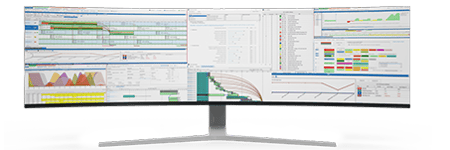Scalability and Growth
As a Purchasing Manager in a chemical manufacturing facility, you are no stranger to the intricacies of sourcing, supplier management, and the critical balance of maintaining inventory levels. But as the industry becomes more complex and globalized, the challenges you face are evolving rapidly. With increasing demands for sustainability, cost efficiency, and risk mitigation, traditional procurement processes are no longer enough to support your organization's growth. To effectively manage scalability and growth, it's essential to leverage advanced planning solutions that integrate seamlessly with enterprise platforms such as SAP, Oracle, Microsoft, Kinaxis, or Aveva.
One such advanced planning solution, PlanetTogether, is particularly valuable for streamlining and enhancing procurement functions, allowing you to scale operations without compromising quality, flexibility, or cost-effectiveness. Here’s a closer look at how integrating PlanetTogether with enterprise platforms can unlock growth potential and foster sustainable scalability within your procurement and purchasing processes.

Challenges of Scalability in Chemical Manufacturing
Chemical manufacturing is marked by a unique set of challenges that impact procurement and purchasing at scale:
Complex Supply Chains: The chemical industry relies on a vast network of suppliers across different regions, with raw materials often sourced from distant locations. This requires a robust system to manage supplier relationships and secure stable material flows.
Stringent Regulatory Compliance: Regulations vary across markets and can impact procurement due to requirements for material certification, environmental standards, and sustainability practices.
Market Volatility: Price fluctuations in raw materials, driven by geopolitical events, natural disasters, and other unpredictable factors, require a dynamic procurement approach that can adjust to changing conditions.
Inventory Optimization: Excess inventory leads to higher holding costs and potential wastage, while insufficient inventory can disrupt production. Striking the right balance becomes increasingly challenging as a company grows.
Sustainability and Environmental Goals: The demand for more sustainable and eco-friendly chemical production adds complexity to sourcing decisions, requiring transparent tracking and supplier accountability.
When scaling operations, these challenges amplify, making it necessary for purchasing managers to adopt a system that can support growth without compromising operational efficiency or quality standards.
![]()

How PlanetTogether Enhances Scalability for Purchasing in Chemical Manufacturing
PlanetTogether’s advanced production scheduling and planning capabilities address scalability challenges by optimizing procurement and aligning it with production needs. When integrated with robust enterprise platforms such as SAP, Oracle, Microsoft, Kinaxis, or Aveva, PlanetTogether transforms procurement processes, creating a collaborative and highly efficient supply chain model. Here's how:
Improved Visibility and Control Over Procurement
With an integrated PlanetTogether and SAP (or other enterprise platform), purchasing managers can achieve real-time visibility into procurement activities across the supply chain. This visibility extends to supplier lead times, inventory levels, demand forecasts, and production schedules, allowing you to make informed purchasing decisions that support scalability.
Demand-Driven Procurement: PlanetTogether synchronizes procurement with production demand by factoring in forecast data and real-time inventory status from SAP or Oracle. This eliminates over-purchasing and reduces the risk of stockouts, ensuring materials are available precisely when needed.
Supplier Performance Tracking: The integration provides insights into supplier reliability and performance, allowing you to make data-driven decisions when selecting or replacing suppliers as your business scales.
Enhanced Forecasting and Demand Planning
As a purchasing manager in chemical manufacturing, one of your main tasks is to anticipate future demand and align procurement to support production. PlanetTogether, integrated with Kinaxis or Microsoft, leverages predictive analytics to create accurate forecasts by analyzing historical data, seasonal trends, and market indicators.
Data-Driven Forecasts: By utilizing the combined forecasting capabilities of PlanetTogether and your enterprise system, you gain a comprehensive view of future material requirements. This proactive approach reduces dependency on last-minute orders and minimizes disruptions in the supply chain.
Scalability with Confidence: Better forecasts translate to precise procurement strategies, allowing you to scale operations confidently, even as demand fluctuates.
Optimized Inventory Management
Inventory optimization becomes increasingly challenging as operations scale. Excess inventory not only ties up capital but also leads to spoilage in the case of perishable or volatile chemicals. On the other hand, underestimating inventory needs risks halting production.
Smart Inventory Control: PlanetTogether’s real-time analytics and integration with ERP systems like SAP or Oracle help optimize inventory levels, ensuring you have the right materials at the right time. This eliminates excess inventory while meeting production demand, leading to significant cost savings.
Demand Variability Management: By identifying patterns in material consumption and demand variability, PlanetTogether provides insights into optimal reorder points and safety stock levels, empowering you to make strategic purchasing decisions at scale.
Automated Workflows for Procurement Efficiency
In a growing operation, managing procurement manually can become time-consuming and prone to errors. PlanetTogether’s integration with enterprise systems offers automation that streamlines purchasing workflows, allowing you to manage larger volumes efficiently.
Automated Order Generation: When inventory reaches a certain threshold, PlanetTogether can trigger automatic purchase orders in systems like SAP or Oracle, ensuring materials are restocked without delay. This reduces the administrative burden on purchasing teams and accelerates procurement cycles.
Exception Management: In case of disruptions, such as supplier delays or unexpected demand spikes, the system flags these exceptions and recommends corrective actions, enabling you to respond swiftly and minimize impact.
Collaboration Across Departments
Scalability requires seamless collaboration among production, procurement, and logistics departments. PlanetTogether’s integration fosters inter-departmental communication, ensuring that procurement aligns with production schedules and business goals.
Real-Time Information Sharing: With integration, stakeholders across departments access the same data on procurement activities, inventory status, and production schedules, eliminating silos and enabling more coordinated decision-making.
Reduced Lead Times: Efficient communication and data sharing between procurement and production lead to reduced lead times, allowing you to scale operations with agility.

Leveraging Scalability for Strategic Growth
As your organization grows, effective procurement is key to maintaining profitability and supporting strategic objectives. Here’s how a PlanetTogether and ERP integration enables strategic growth:
Sustainable Sourcing
PlanetTogether’s insights into supplier performance and environmental metrics help you prioritize sustainable sourcing options. The integration tracks sustainability indicators, such as carbon footprint, energy use, and waste generation, aligning your procurement practices with corporate social responsibility (CSR) goals.
Cost Management
Scaling with PlanetTogether and ERP integration reduces operational inefficiencies that often lead to higher procurement costs. By leveraging demand-driven procurement, automated workflows, and inventory optimization, you can significantly reduce costs related to excess inventory, rush orders, and supplier-related risks.
Risk Mitigation
In today’s global landscape, managing risk is essential for scalability. PlanetTogether’s integration with ERP platforms offers comprehensive risk assessment tools, enabling purchasing managers to identify and mitigate potential issues in the supply chain proactively. With real-time insights, you can make contingency plans for supplier disruptions, pricing volatility, and regulatory changes, creating a resilient supply chain that supports sustainable growth.
Enhanced Supplier Partnerships
The insights gained from integrated data can help foster stronger supplier relationships. By consistently evaluating supplier performance, you can collaborate more closely with key suppliers to improve quality, reduce lead times, and negotiate better terms, all of which are essential for scaling operations successfully.
Scalability in chemical manufacturing requires a strategic approach to procurement, one that balances cost, quality, and sustainability while supporting growth. PlanetTogether’s integration with enterprise platforms like SAP, Oracle, Microsoft, Kinaxis, or Aveva offers purchasing managers the tools they need to build a scalable and resilient procurement process. From automated workflows and data-driven forecasts to optimized inventory management and risk mitigation, this integration empowers you to manage larger volumes, enhance supplier partnerships, and drive sustainable growth.
In a world where adaptability is crucial, PlanetTogether enables chemical manufacturers to scale procurement processes seamlessly, ensuring that as your company grows, your procurement function grows with it—efficiently, sustainably, and strategically. Embrace the potential of integrated planning solutions to make procurement a cornerstone of your organization’s success.
Are you ready to take your manufacturing operations to the next level? Contact us today to learn more about how PlanetTogether can help you achieve your goals and drive success in your industry.
Topics: cost management, PlanetTogether Software, Integrating PlanetTogether, Optimized Inventory Management, Enhanced Forecasting and Demand Planning, Risk Mitigation, Chemical Manufacturing, Improved Visibility and Control Over Procurement, Automated Workflows for Procurement Efficiency, Collaboration Across Departments, Sustainable Sourcing, Enhanced Supplier Partnerships




















LEAVE A COMMENT